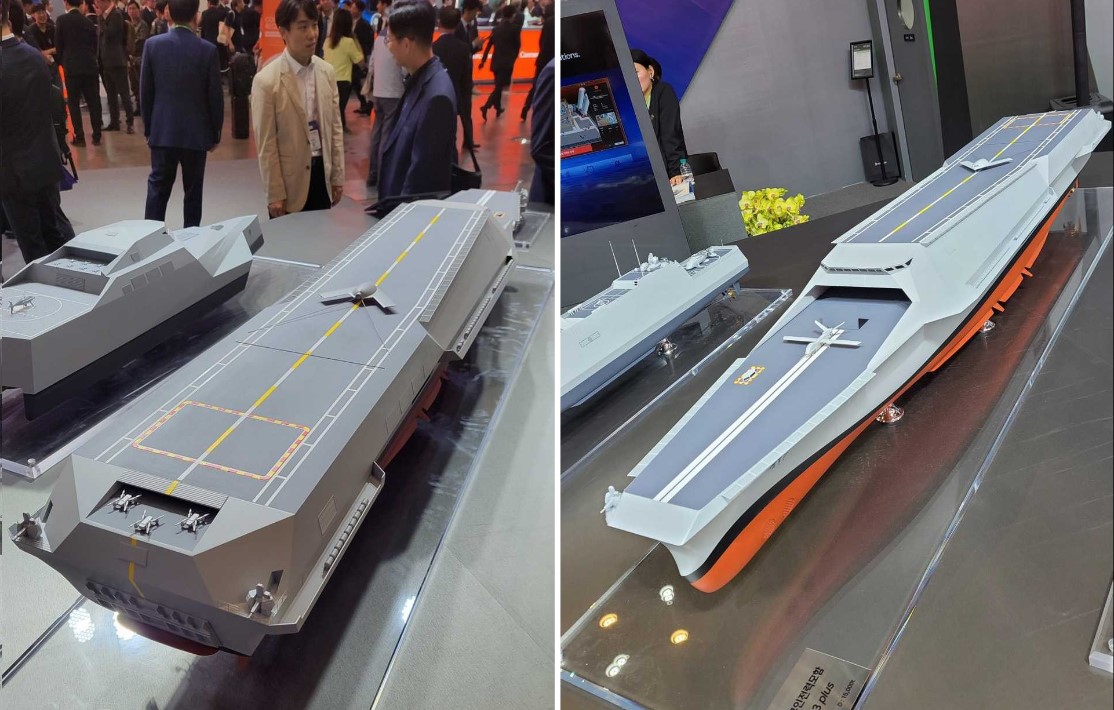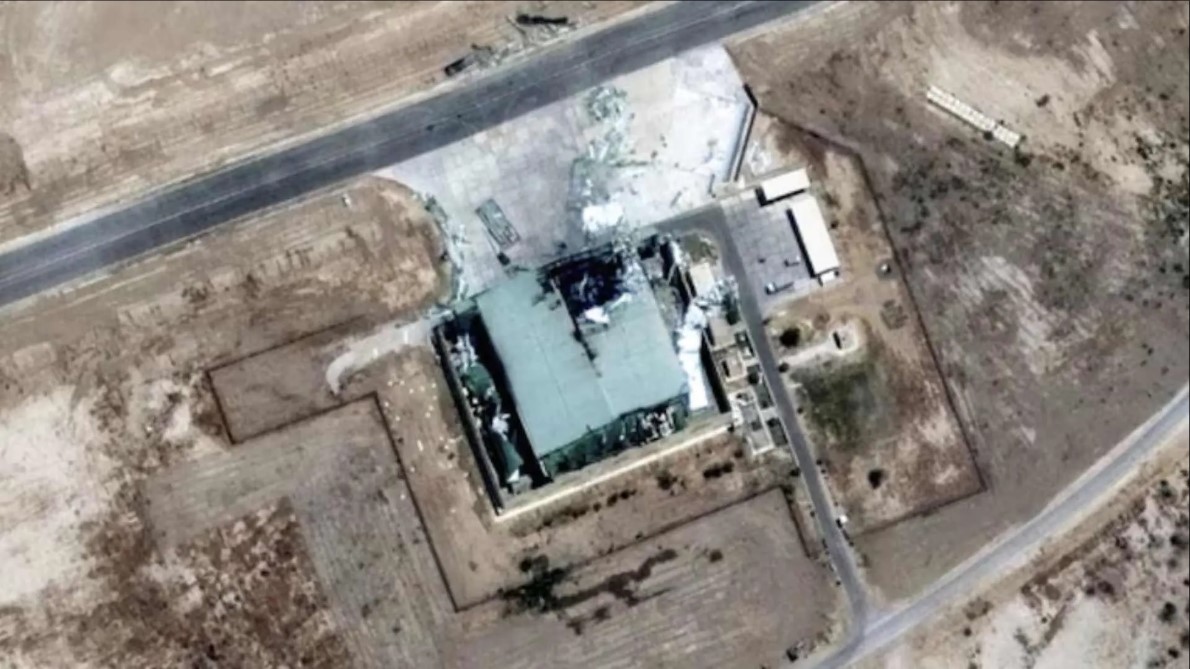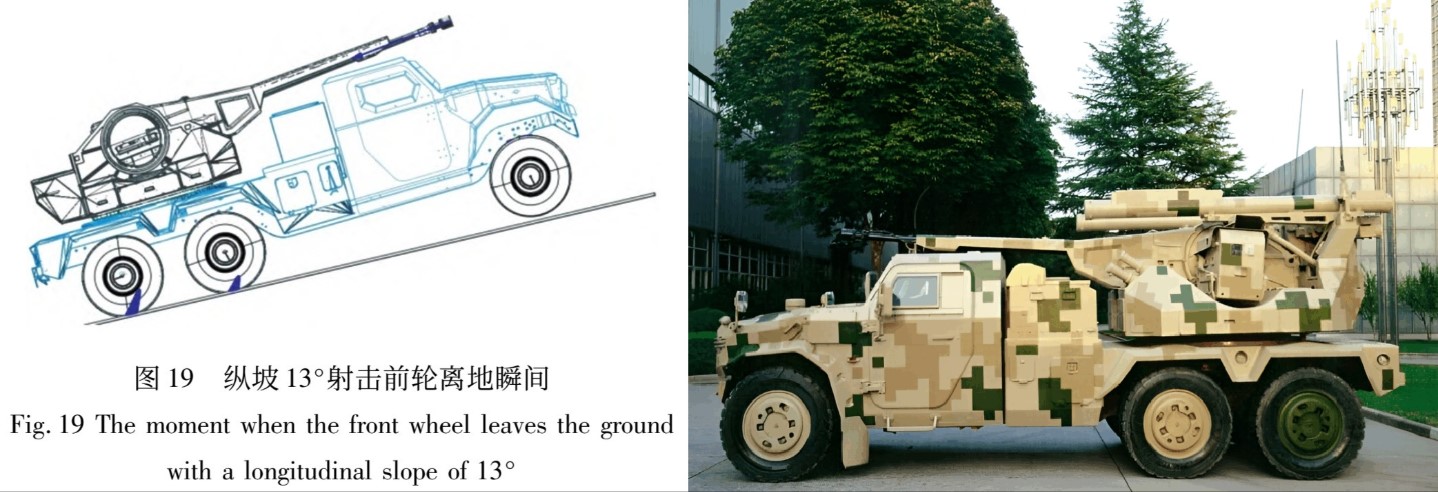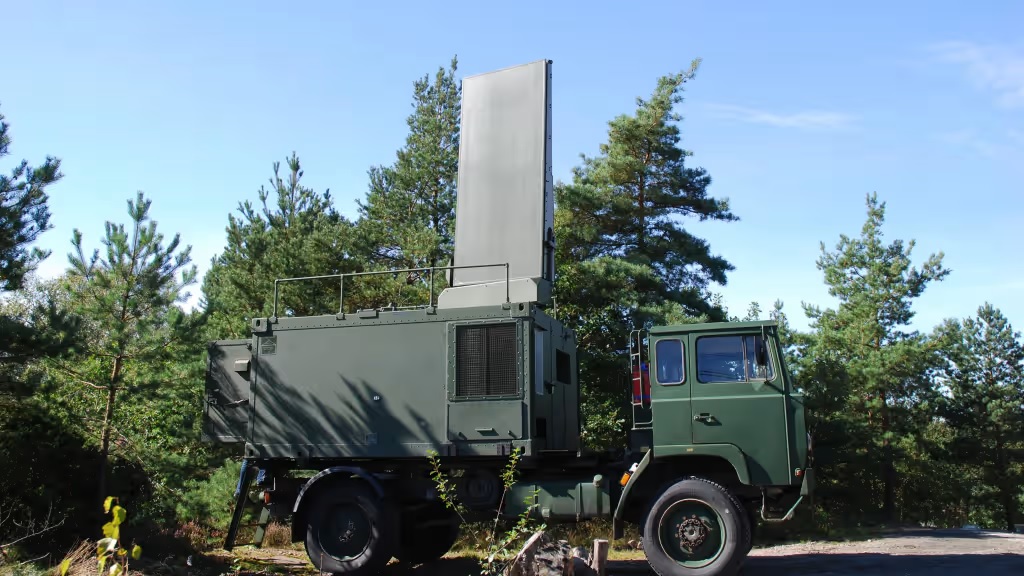World
South Korea has revealed a bold and futuristic vision for the future of naval warfare with the debut of its HCX-23 Plus drone carrier concept at MADEX 2025 in Busan. Designed by HD Hyundai Heavy Industries (HD HHI), the HCX-23 Plus is not just a new type of ship — it's a radical rethinking of how naval operations could function in the age of drones and artificial intelligence. Unlike traditional aircraft carriers, which rely heavily on manned aircraft and large command structures, the HCX-23 Plus is designed to operate primarily with unmanned systems and AI. This ship has no island or bridge superstructure. Instead, its command systems are housed internally and powered by AI, reducing the crew needed and enhancing stealth. The entire top of the ship is a flat deck, separated into two areas: one for launching and landing fixed-wing drones at the rear, and another recessed section at the front likely used for vertical take-off and landing (VTOL) drones. The model of the ship shown at MADEX 2025 revealed its futuristic appearance. The ship’s design uses sharp, angular surfaces and a mix of grey and black paint above the waterline to minimize radar detection. Below the waterline, the hull is painted red, indicating a high-speed and hydrodynamic design. Observers noted unusual shapes along the sides of the hull, which may suggest hidden missile launchers or modular spaces for different mission payloads. The HCX-23 Plus is part of a bigger vision by HD HHI to lead in autonomous naval technologies. It is designed to work in combination with unmanned surface ships and mobile command vessels, all of which would be connected through advanced digital networks. The ship’s AI is expected to manage logistics, mission planning, and battlefield decisions with minimal human intervention — an approach that reflects a shift toward automation and faster response times in naval combat. The ship’s flat deck and lack of superstructures make it easier to manage drones, while also reducing its visibility to enemy radar. It’s built to handle surveillance, electronic warfare, defensive air operations, and rapid-strike missions. As South Korea considers whether to proceed with its expensive CVX aircraft carrier project, the HCX-23 Plus offers a potentially more flexible and cost-effective alternative. The HCX-23 Plus is more than a military project; it’s a statement about where naval warfare is heading. With its AI-focused design, stealthy profile, and dedication to unmanned operations, this drone carrier signals South Korea’s ambition to be a major force in future naval strategy. As it takes center stage at MADEX 2025, the HCX-23 Plus highlights how the lines between machines and warfighters are increasingly being redefined — and South Korea is determined to lead the way.
Read More → Posted on 2025-05-29 13:54:14World
Swedish defence company Saab has secured a major contract from the Swedish Defence Materiel Administration (FMV) to upgrade the country’s Visby-class corvettes with the state-of-the-art Sea Ceptor air defence system. This significant step is part of Sweden’s broader naval modernization programme and is valued at approximately SEK 1.6 billion (around $166 million). The Sea Ceptor system, developed by MBDA, will be integrated into all five Visby-class stealth corvettes, boosting their air and missile defence capabilities dramatically. These enhancements are aimed at increasing the operational flexibility of the Swedish Navy and strengthening its ability to defend against modern aerial threats across longer distances and over larger operational zones. According to Mats Wicksell, Head of Saab’s Kockums business unit, “This modification strengthens both Sweden’s and NATO’s air and missile defence by increasing the Swedish Armed Forces’ operational capability and ability to operate across the entire conflict spectrum. With the air defence system on board, the Visby-class corvettes will continue to be a vital platform for many years to come.” Why This Matters The Visby-class ships are renowned for their stealth technology and are among the most advanced corvettes in the world. Outfitting them with the Sea Ceptor system will greatly enhance Sweden’s ability to defend its maritime borders and participate in joint NATO defence efforts, especially amid rising global security challenges. Sea Ceptor uses the Common Anti-air Modular Missile (CAMM) to protect naval vessels against multiple simultaneous airborne threats, including combat aircraft and precision-guided munitions. It offers a 360-degree coverage and a high rate of fire against multiple targets, making it a modern and powerful upgrade over existing systems. Timeline and Background FMV had already signed an earlier agreement with MBDA for the delivery of CAMMs. Saab’s role now is to integrate this system into the Visby-class corvettes. The installation and integration work is expected to commence in early 2026. This decision is part of a long-term plan set in motion by the Swedish government as early as 2020, when they approved the concept of adding an air defence system to the Visby fleet. The process gained momentum in 2023 when MBDA signed a deal to provide the necessary missile components. About the Visby-Class Corvettes Built between 2000 and 2009 by Saab’s Kockums shipyard in Karlskrona, the Visby-class consists of five versatile corvettes designed for multi-role naval operations such as anti-surface warfare (ASuW), anti-submarine warfare (ASW), escort duties, and mine countermeasures. Key Features of Visby-Class Corvettes: Length: 73 meters Displacement: 640 tons Top Speed: ~35 knots Crew: 43 Propulsion: Diesel engines and gas turbines powering water jets Primary Armaments: Bofors 57 mm stealth gun, RBS 15 Mk II anti-ship missiles, Torped 45 submarine torpedoes Sensors: Advanced radars (Sea GIRAFFE AMB, Ceros 200), sonar systems (hull-mounted, towed array, and variable depth) Their revolutionary stealth design minimizes radar, visual, infrared, and acoustic signatures. From concealed missile launchers to a hidden main gun turret, these ships are crafted to avoid detection while delivering a powerful punch. Although three of the five ships can accommodate helicopters for landing, takeoff, and refueling, they do not have hangars for long-term storage. The Strategic Importance Integrating the Sea Ceptor system aligns with Sweden’s increasing focus on modernizing its armed forces and contributing more actively to regional and NATO security. The enhanced corvettes will be capable of providing robust protection for Sweden’s territorial waters and critical naval missions. This development ensures that the Visby-class corvettes, already considered a symbol of Sweden’s naval innovation, will remain relevant and capable well into the future.
Read More → Posted on 2025-05-29 10:14:11World
In a significant leap for battlefield technology, the Israeli Ministry of Defense has officially confirmed the operational use of high-powered laser weapons by the Israeli Air Force (IAF) during the ongoing Swords of Iron war. This marks the first time Israel has used such directed energy weapons in real combat, and early results indicate high effectiveness in intercepting enemy threats. These advanced laser systems were developed through a collaboration between Rafael Advanced Defense Systems and the Directorate of Defense Research and Development (DDR&D), under the umbrella of the Ministry of Defense. The weapons were used by soldiers from the IAF’s Aerial Defense Array, who operated prototype models directly on the battlefield. According to officials, the systems intercepted numerous incoming aerial threats with precision, showcasing a high interception success rate that has helped prevent casualties and damage. The development of these laser weapons is part of a broader push by Israel to strengthen its multi-layered air defense capabilities. At the center of this effort is the “Iron Beam” project—an advanced laser-based air defense system that complements existing systems like Iron Dome and David’s Sling. Though Iron Beam is still in development and expected to be officially inducted later this year, the recent use of laser prototypes on the battlefield offers a preview of what future warfare might look like. What sets these laser weapons apart is their ability to neutralize threats at the speed of light without relying on costly interceptor missiles. Instead, they focus a beam of directed energy on incoming rockets, drones, or other aerial threats, heating them until they fail mid-air. This not only lowers the cost of defense per shot but also allows for sustained, repeated use against multiple threats—especially useful in scenarios involving mass drone or rocket attacks. Rafael and DDR&D engineers have been working on laser technology for decades, gradually advancing its power, range, and precision. This war has now provided a proving ground for those efforts. The Defense Ministry praised the teams behind the technology for adapting so rapidly to real-time conditions, allowing soldiers to deploy it with operational success in a live combat setting. For Israel, this marks a major step forward in its strategic defense capabilities. The success of these directed energy systems reflects both years of scientific innovation and the urgency created by ongoing regional threats. With the Iron Beam soon to join the arsenal officially, and operational laser prototypes already proving their worth, Israel is moving toward a future where laser weapons may become a regular part of defense strategy—silent, swift, and potentially game-changing.
Read More → Posted on 2025-05-29 09:54:54India
Fresh satellite images have revealed significant destruction at Pakistan’s Murid air base following the May 10 military strikes carried out by the Indian Air Force (IAF). The latest high-resolution images have confirmed the appearance of a large, three-metre wide crater, located just 30 metres from one of the main entrances of the strategic airbase. The images also clearly show extensive damage to the buildings, rooftops, and structures within the airbase. Notably, one of the most critical aspects of this revelation is the confirmation of damage to an underground facility at the Murid air base — a site believed to be vital for Pakistan’s drone and missile operations. This information was brought to light by geo-intelligence researcher Damien Symon, who has consistently reported on the structural conditions of Pakistan’s military bases. According to him, the Murid air base is heavily fortified, secured with double fencing, multiple watchtowers, and strict access control, which highlights its importance as a high-value military target. The underground sections of this base may have been used for storing special equipment or as protected shelters for personnel. Located in Chakwal, around 150 kilometres from the Line of Control, the Murid air base operates as a forward operating location for the Pakistan Air Force. It functions in coordination with other major air stations like Sargodha air base and Nur Khan air base in Rawalpindi. A careful comparison between the satellite images taken before and after the May 10 air strikes shows clear evidence of destruction. The April 16 images presented an intact facility, but the images taken after the strikes display considerable damage to multiple structures. One of the significant buildings, believed to be a command-and-control centre near the UAV complex, shows visible signs of collapse, with a portion of the roof caved in and the outer walls visibly damaged. Defense experts believe that such precision strikes by the IAF not only destroyed surface-level targets but also inflicted serious damage to the underground complexes, indicating a well-planned military operation aimed at crippling key operational centres of the Pakistan Air Force. The Murid air base has long been considered a sensitive installation, closely linked to Pakistan’s aerial defense and unmanned systems program. These fresh images, offering undeniable proof of destruction, underscore the impact of the May 10 strikes and mark a significant development in the ongoing tensions between the two countries. While Pakistan has remained tight-lipped about the exact extent of the damages, independent satellite imagery continues to expose the aftermath of the attacks, revealing the operational vulnerability of even the most fortified military establishments.
Read More → Posted on 2025-05-29 09:35:42Space & Technology
In a bold step toward reshaping the future of satellite technology, two former ISRO scientists, Christopher Parmar and Anupam Kumar, have launched a space-tech startup named Orbitt Space, based in Ahmedabad. Founded in February 2025, the company has already made headlines by securing $1 million in pre-seed funding to develop an innovative propulsion system designed for Ultra Low Earth Orbit (ULEO) — a region of space that lies below 250 kilometers in altitude. Unlike conventional satellite zones, ULEO remains largely unexplored due to intense atmospheric drag and fuel limitations, making sustained operations nearly impossible with traditional propulsion methods. Satellites in this region typically exhaust their fuel quickly, limiting mission life to just a few days or weeks. But Orbitt Space has a game-changing solution. The startup is building a next-generation air-breathing electric propulsion system, a technology that draws in the residual gases present in the atmosphere at ULEO levels and uses them as a propellant. This system eliminates the need to carry bulky fuel tanks, enabling satellites to operate continuously for 5 to 7 years in this challenging environment — a feat that was once thought unattainable. By using the orbit’s own resources to generate thrust, Orbitt’s approach not only extends mission duration but also addresses the growing problem of space debris. Unlike satellites in higher orbits that can remain floating as junk for decades, satellites in ULEO naturally deorbit due to atmospheric drag, ensuring they don’t become long-term clutter in space. The benefits of operating in ULEO extend far beyond sustainability. Because of the lower altitude, satellites can capture sharper images and deliver data with faster response times, making them ideal for applications like real-time Earth observation, low-latency communication, climate monitoring, and national security surveillance. Moreover, since ULEO has much lower radiation levels compared to higher orbits, Orbitt's satellites can use commercial-grade electronics instead of expensive, radiation-hardened components — slashing costs and simplifying design. While Low Earth Orbit (LEO), especially the 500–700 km range, has become increasingly congested with more than 40,000 tracked objects and millions of smaller debris fragments, ULEO remains a clean and open zone. Orbitt sees this as a “blue ocean” opportunity, offering safer, cheaper, and more efficient satellite operations in an underutilized part of space. The $1 million raised — led by pi Ventures with support from IIMA Ventures — will be used to build a highly skilled team of 8 to 10 scientists and engineers, many of them expected to come from ISRO. The immediate focus is on developing a working prototype of the propulsion system and conducting environmental tests. The company has laid out a clear three-phase roadmap: first, building and validating the prototype on the ground; second, performing rigorous testing for space qualification; and third, launching their first operational satellite into ULEO by 2027 or 2028. Orbitt’s proximity to IIM Ahmedabad gives it access to ISRO testing infrastructure, while discussions are already underway with major potential clients, including TATA Advanced Systems. The startup is also exploring partnerships through IN-SPACe, the Indian government’s initiative to foster private sector collaboration in the space domain. Looking ahead, Orbitt Space envisions a major shift in the $13 billion satellite market, with many operations moving from LEO to ULEO due to the clear advantages in performance, cost, and sustainability. Their air-breathing propulsion technology could play a central role in this transition, offering a pathway to cleaner, more durable, and responsive satellites. By harnessing their ISRO expertise and pushing the boundaries of what’s possible in orbital mechanics, Orbitt Space is not just launching a new product — they are opening up an entirely new frontier in space exploration. Their innovation could place India at the forefront of next-generation satellite technology and set new standards for how we think about access to and sustainability in outer space.
Read More → Posted on 2025-05-29 09:31:39India
In a significant development, a recent report has brought to light an alleged precision strike carried out by the Indian Air Force (IAF) on Pakistan’s Bholari Air Base. This operation, reportedly executed using long-range cruise missiles, is said to have targeted a critical hangar housing key assets of the Pakistan Air Force (PAF). Major Losses for PAF at Bholari According to the report, the hangar contained a Saab 2000 Airborne Early Warning and Control (AEW&C) aircraft along with three to four fighter jets of Western origin. These aircraft were reportedly destroyed in the strike, dealing a substantial blow to Pakistan’s aerial surveillance and operational capabilities. The Saab 2000 AEW&C, equipped with the sophisticated Erieye radar system, is a vital component of Pakistan’s air defence strategy. It serves as an airborne radar station, providing early warning of incoming threats and coordinating air operations. The loss of this system would severely affect the PAF’s ability to monitor its airspace and manage combat operations effectively. In addition to the AEW&C, the reported destruction of multiple fighter jets further reduces the immediate operational strength of the PAF. Debris clearance operations at the site have reportedly not yet begun, indicating the extent of damage and the possible challenges faced by Pakistan in restoring the base’s operational status. Operation Monitored by Indian Satellites and AWACS The operation is believed to have been meticulously planned, with real-time surveillance provided by Indian satellites and Airborne Warning and Control System (AWACS) aircraft. This integration of space-based and airborne intelligence allowed Indian forces to monitor the situation live, ensuring the strike achieved its intended objective with high precision. This strike is seen as a demonstration of India’s growing military capabilities, particularly in the domain of precision strikes using advanced missile systems and intelligence-driven operations. It reflects a shift towards a modern, technology-based approach in handling cross-border threats. Additional Strikes in Pakistan’s Punjab Region In a separate but related incident, the IAF reportedly targeted another Pakistani air base located in the Punjab sector. In this operation, three missiles were said to have struck different sections of the base’s runways, making them unusable for at least eight hours. This temporary disabling of the airfield likely grounded PAF aircraft and hampered their operational readiness. Such attacks, aimed at crippling air bases by damaging runways and key infrastructure, serve to restrict the enemy’s ability to launch air operations and respond effectively. Strategic Message and Regional Impact These reported strikes, though unconfirmed by official Pakistani sources, carry a clear strategic message. They showcase India’s ability to conduct high-precision, intelligence-backed military operations aimed at high-value enemy assets while maintaining operational secrecy. The alleged destruction of the Saab 2000 AEW&C aircraft is particularly significant, as it represents a crucial element of Pakistan’s airborne early warning and command network. Without such platforms, the PAF’s situational awareness and coordination during any conflict scenario would be notably diminished. This operation, reportedly codenamed Operation Sindoor, highlights the Indian Air Force’s preparedness, advanced strike capability, and growing emphasis on integrating space-based and airborne surveillance into combat missions. While official details remain classified and Pakistan is unlikely to confirm the full extent of the damage, the implications of this reported strike are expected to be closely monitored by global defence analysts. It signals a proactive approach by India in addressing regional security threats and neutralizing strategic enemy assets with precision.
Read More → Posted on 2025-05-29 09:26:03India
In a significant operational breakthrough for the security forces in Jammu and Kashmir, a meticulously coordinated Cordon and Search Operation (CASO) was launched in the Baskuchan area of South Kashmir’s Shopian district. The operation was executed by the Special Operations Group (SOG) of Shopian, in close coordination with the 44 Rashtriya Rifles (RR) of the Indian Army and the 178 Battalion of the Central Reserve Police Force (CRPF), following credible intelligence regarding terrorist movement in the region. Acting on specific input, the joint team swiftly cordoned off the area early in the morning. During the search operation, movement was detected in a nearby orchard, confirming the presence of armed terrorists. In what could have escalated into a deadly encounter, the situation was tactically handled by the joint forces. Instead of opening fire immediately, the security personnel engaged in a calculated containment maneuver that led to a peaceful surrender — a rare and strategically significant outcome in counter-insurgency operations in the Valley. The two individuals who surrendered have been identified as Irfan Bashir and Uzair Salam, both reportedly associated with the banned terror outfit Lashkar-e-Taiba (LeT). According to initial reports, the duo were categorized as “hybrid terrorists” — a term used for individuals who operate covertly for terrorist groups while continuing to maintain an outward appearance of civilian life. The surrender marks an important success for ongoing deradicalization efforts, particularly in South Kashmir, a region that has witnessed frequent militant activity in recent years. Their decision to lay down arms not only saved lives — including their own — but also provided an intelligence breakthrough, potentially aiding ongoing investigations into terrorist networks and logistics in the region. Significant Recoveries from the Site: Following their surrender, the joint team recovered a cache of arms, ammunition, and personal items from the suspects. These include: 02 AK-56 assault rifles 04 magazines compatible with AK-series rifles 102 live rounds of 7.62×39mm caliber ammunition 02 hand grenades, indicative of planned violent engagement 02 utility pouches for ammunition and grenades ₹5,400 in Indian currency, suspected to be operational cash 01 mobile phone and 01 smartwatch, potentially used for communication and tracking 02 packets of biscuits, likely part of field sustenance 01 Aadhaar card, aiding in identity verification All recovered items have been secured as evidence and will undergo forensic examination. Digital devices such as the mobile phone and smartwatch are expected to be analyzed for communication records, location data, and potential links to other operatives. An FIR has been registered under the relevant sections of the Indian Penal Code, Arms Act, and Unlawful Activities (Prevention) Act (UAPA), and further investigation is underway to map out the wider network of collaborators and handlers. Broader Implications: This operation comes at a time when security forces have intensified counter-terror efforts across the Kashmir Valley, particularly targeting hybrid militants who blend into civilian populations and are activated for specific tasks. The successful surrender of Irfan and Uzair is being hailed not just as a tactical win, but also as a reflection of effective intelligence gathering, coordination among security agencies, and a nuanced operational approach that prioritizes human lives where possible. Officials stated that efforts will continue to encourage local militants, especially those lured into militancy through online propaganda or coercion, to return to the mainstream. The duo will likely be debriefed over the coming days to extract further information on their handlers, recruitment patterns, and potential targets. Security forces have reiterated their commitment to maintaining peace and order in the region while upholding human rights and providing opportunities for misguided youth to return to a life of dignity.
Read More → Posted on 2025-05-29 09:18:23World
A major leap in European defence innovation is underway as the VANTAGE project, led by Latvia's Latvijas Mobilais Telefons (LMT), has been awarded up to €10.09 million by the European Defence Fund (EDF). This significant investment will drive the creation of a new generation of long-range tactical unmanned aerial vehicles (UAVs), designed to enhance Europe's defence capabilities and operational autonomy. The VANTAGE project, with a total estimated budget of €10.88 million, was selected under the EDF’s 2024 call for collaborative defence research and development. It brings together a consortium of eight organizations from seven European countries, united by a shared goal: to deliver a modular, future-ready UAV system capable of performing a wide range of defence missions. At the heart of this initiative lies an ambitious technological vision. The UAV developed under VANTAGE will be designed with vertical take-off and landing (VTOL) capabilities, enabling it to operate in challenging environments without relying on traditional runways. It will be equipped for both C4ISR (Command, Control, Communications, Computers, Intelligence, Surveillance, and Reconnaissance) and kinetic missions, combining intelligence-gathering functions with direct action capabilities. One of the key innovations of the system is its modular architecture. This flexibility allows the UAV to be adapted quickly for various mission profiles and integrated with a broad array of payloads, including advanced sensors and navigation technologies that can operate effectively even in GPS-denied zones. Such adaptability ensures that the system remains relevant and effective in evolving battlefield conditions. According to Kaspars Pollaks, Director of the Defence Technology Department at LMT, the VANTAGE project is not just a technological breakthrough—it’s a strategic advancement for Europe’s defence industry. He highlighted the importance of collaboration and the lessons learned from ongoing global conflicts, particularly the war in Ukraine, where UAVs have proven essential to modern combat. Pollaks described the initiative as a forward-thinking effort that reflects Europe’s determination to develop sovereign defence capabilities. “By bringing together our unique experience, expertise, and resources from across borders, we are building a future-ready capability that will strengthen Europe’s security, enhance operational flexibility, and set new standards for cooperation within the defence industry,” he said. Over the next 36 months, the VANTAGE project will move through all stages of development—starting from initial studies and design, progressing to prototyping, and finally culminating in rigorous system testing. A key goal is to ensure that the drone platform remains interoperable with existing systems and adaptable to future technological needs. The consortium behind VANTAGE includes: Latvijas Mobilais Telefons SIA (Latvia) – Project Coordinator C&V Defence (Belgium) CAVOK UAS (France) Centro de Observación y Teledetección Espacial SAU (Spain) Vegvisir (Estonia) INCAS București – National Institute for Aerospace Research “Elie Carafoli” (Romania) M3 Systems Belgium UAV Navigation – Grupo Oesía (Spain) Together, these partners represent a blend of defence technology, aerospace engineering, and operational expertise, reflecting a pan-European effort to create cutting-edge solutions for modern security challenges. As Europe continues to prioritize defence resilience and strategic autonomy, projects like VANTAGE underscore a growing emphasis on innovation, collaboration, and readiness for the complex threats of tomorrow.
Read More → Posted on 2025-05-28 15:46:27World
China has developed a new short-range air defense system known as the SWS3 35mm Gun-Missile System. This mobile weapon platform is designed to deal with a wide range of modern aerial threats such as drones, cruise missiles, low-flying aircraft, and precision-guided munitions — all of which pose significant risks to military bases, convoys, and critical infrastructure on the battlefield. What makes the SWS3 stand out is its combination of dual 35mm autocannons and surface-to-air missile pods, both mounted on versatile 6×6 and 4×4 armored vehicles. This mobility ensures that the system can move swiftly with advancing troops or be repositioned quickly to defend vital points in dynamic combat situations. The system comes equipped with advanced radar arrays and electro-optical targeting systems. These allow the SWS3 to autonomously detect, track, and engage incoming targets with high accuracy, even in complex environments where multiple threats may appear at different speeds and altitudes. One of the key features of the SWS3 is its unique “1+1 interception” capability. In this approach, both the autocannons and missiles are used in a coordinated attack on an incoming target. The idea is to increase the chances of a successful interception — if one weapon misses or is insufficient, the other follows immediately to finish the job. This layered engagement strategy is especially useful in scenarios where enemy forces might launch saturation attacks with swarms of drones or multiple missiles. Specifications of the SWS3 35mm Gun-Missile System: Primary Armament: Two 35mm autocannons with a high rate of fire suitable for short-range defense against fast-moving targets. Missile Component: Surface-to-air missiles (exact type undisclosed) capable of engaging aerial targets at longer ranges than the cannons. Mounting Platforms: Available on 6×6 and 4×4 armored vehicles for flexible deployment across different terrain types. Targeting & Detection: Modular radar arrays for all-weather detection. Electro-optical tracking systems for precise identification and targeting. Fire control system supporting integrated, automated, or networked operations. Engagement Range: The 35mm cannons have an effective range of around 3 to 4 kilometers, while the missile system is designed to engage threats at ranges reportedly beyond 6 kilometers. Operational Role: Protection of frontline troops, military convoys, command posts, airbases, and other high-value assets against low-altitude and short-range aerial threats. The development of the SWS3 reflects China’s growing focus on countering the increasing use of small unmanned aerial vehicles (UAVs) and precision-guided weapons in modern warfare. While the system takes inspiration from similar platforms like the Russian Pantsir-S1, German MANTIS, and the U.S. M-SHORAD, it has been tailored to suit the operational needs of the Chinese military and the unique security environment in which it operates. As aerial threats evolve, especially with the rise of drone swarms and stealthy cruise missiles, systems like the SWS3 will play a crucial role in protecting troops and infrastructure from surprise attacks in both peacetime and during conflict.
Read More → Posted on 2025-05-28 15:43:41World
At FEINDEF 2025, Saab showcased the future of its renowned Arthur (Artillery Hunting Radar) system, presenting an updated development roadmap for the fully digitised Arthur Model D. As artillery warfare once again dominates modern battlefields — notably witnessed in the Russia-Ukraine conflict — counter-battery capabilities like the Arthur radar have become essential for modern militaries. Why Counter-Battery Radars Matter Today In conflicts like the ongoing war in Ukraine, artillery, mortars, and rocket systems are responsible for up to 80% of battlefield casualties. With drones now being used for target spotting and fire correction, the need to rapidly detect and locate incoming indirect fire has never been more urgent. To give context, since the start of the Ukraine war in 2022, Russia has fired between 30,000 to 50,000 artillery rounds per day, a staggering number that highlights how crucial it is to locate enemy artillery positions quickly for immediate retaliation. Without such systems, forces risk devastating losses and a weakened defensive capability. The Evolution of Arthur: From Mod C to Mod D The original Arthur system was designed by Saab in the late 1980s and delivered in the early 1990s. It was one of the first lightweight, mobile Weapon Locating Systems (WLS) of its kind. Over the decades, Saab continuously upgraded the system, resulting in the advanced Arthur Mod D. The transition from Mod C’s travelling wave tube (TWT) technology to Mod D’s active phased array radar, using Gallium Nitride (GaN) transmit/receive modules, represents a major leap. Not only does this make the radar system lighter and more compact, but it also enters the realm of software-defined radars, allowing for continuous updates and adaptability on the digital battlefield. Key Features and Specifications of Arthur Mod D Antenna Type: Active Phased Array Radar Modules: Gallium Nitride (GaN) T/R modules Mobility: Containerised configuration (10-foot and 12-foot versions), vehicle-agnostic Mass: Less than 1,400 kg (without power supply and communication systems) Detection Range: 300 mm rockets: Over 60 km 122 mm rockets & 120 mm mortars: Over 50 km 152 mm artillery shells: Over 30 km (all with 90% detection probability) Accuracy: Mortar tubes: CEP of 0.15% of range Howitzers and rocket launchers: CEP of 0.20% of range Control: Remote-operated via laptop-based consoles Deployment: Capable of rapid relocation to avoid detection and targeting The British Army’s 5th Regiment Royal Artillery is the first user of Arthur Mod D, which they have nicknamed Taipan. These radars replaced the older Arthur Mod B (Mamba) systems delivered back in 2005. Adaptability and Manoeuvre on the Battlefield Modern warfare demands not only precision but also survivability. Weapon locating radars like Arthur are prime targets for enemy forces and electronic warfare systems. The Arthur Mod D’s agility allows it to transmit briefly and relocate rapidly, following a "radar manoeuvre" doctrine similar to infantry movement tactics. For maximum effectiveness, operational doctrine recommends deploying three radars simultaneously to maintain continuous coverage while each alternates between scanning and relocating. This ensures reliable detection while reducing the risk of being targeted. Additionally, the radar’s static antenna design and compatibility with multispectral camouflage help lower its visual and thermal signatures, essential for evading detection by drones equipped with thermal imaging. Arthur’s Future: Saab’s Roadmap At FEINDEF 2025, Saab highlighted its clear roadmap for Arthur Mod D’s future. Key upgrades planned include: Over 50% increase in detection range, primarily achieved through software enhancements Power Save Mode to reduce energy consumption and minimise the radar’s acoustic and thermal signatures Continuous software-defined capability updates based on lessons from recent conflicts, particularly in Ukraine Saab’s R&D division remains focused on integrating battlefield feedback quickly, ensuring Arthur stays relevant in fast-evolving combat environments. Global Adoption of Arthur Arthur radars are currently in service with multiple NATO nations and other global militaries, including: Czech Republic Denmark Greece Italy Sweden Spain United Kingdom South Korea Several other non-disclosed nations also rely on the Arthur system for their counter-battery operations. Conclusion As artillery reclaims a dominant role in modern warfare, advanced counter-battery systems like the Arthur Mod D are indispensable. Saab’s clear commitment to digital upgrades, software flexibility, and battlefield survivability ensures that Arthur will continue to protect forces and enable effective retaliatory strikes for years to come. The Arthur Mod D is not just a radar — it’s a dynamic, modern battlefield sensor designed for a new era of warfare, where information speed and system mobility are as important as raw firepower.
Read More → Posted on 2025-05-28 15:40:57
India Revives ₹44,000 Cr Minesweeper Project: Plans to Build 12 Next-Gen Mine Countermeasure Vessels
India
India has reactivated its long-stalled ₹44,000 crore project to domestically build 12 state-of-the-art Mine Countermeasure Vessels (MCMVs), a critical capability gap that the Indian Navy has been grappling with for over a decade. With fresh momentum, the initiative signals a significant push towards strengthening coastal and naval security, particularly in the face of growing maritime threats and an increasingly complex underwater mine warfare landscape. The Legacy Gap in Naval Mine Countermeasures Naval mines, often termed the "weapons that wait," pose one of the most silent yet devastating threats to maritime operations. Despite this, the Indian Navy has lacked a dedicated minesweeper fleet since 2016, when the last of its 12 Soviet-origin Pondicherry-class MCMVs were decommissioned. Since then, the Navy has been without a dedicated capability to detect and neutralize sea mines—a vulnerability in a region of high maritime traffic and contested waters. Several attempts to replace the aging fleet stalled over issues related to costs, technology transfer, and quality compliance. The most notable setback came in 2018, when the proposed ₹32,000 crore project with South Korea’s Kangnam Corporation—meant to be executed with Goa Shipyard Limited (GSL)—was scrapped over pricing and local content issues. Revival Under New Guidelines In 2025, the Ministry of Defence has finally rebooted the project under the "Make in India" initiative, with an expanded budget of ₹44,000 crore. Goa Shipyard Limited will remain the primary shipbuilder, but this time the project will likely involve newer, global partnerships under updated procurement models like the Strategic Partnership (SP) model or Buy and Make (Indian). Officials have hinted that negotiations are already underway with leading global MCMV manufacturers such as Italy’s Intermarine, Sweden’s Saab, and France’s Naval Group, among others. Advanced MCMV Capabilities in Focus The upcoming Indian MCMVs are expected to incorporate the latest in mine countermeasure technologies, with capabilities far beyond traditional minesweeping: 1. Non-Magnetic Hull Construction To prevent triggering magnetic mines, the MCMVs will be constructed using non-magnetic materials, most likely glass-reinforced plastic (GRP) or advanced carbon fiber composites. GRP hulls also offer better shock resistance and longevity in mine-laden waters. 2. Hull-Mounted and Towed Sonar These vessels will be equipped with state-of-the-art High-Frequency Hull-Mounted Sonars (HF-HMS) and Variable Depth Sonars (VDS) to detect both moored and bottom mines in different seabed environments. 3. Unmanned Mine Disposal Systems Each MCMV will likely carry a suite of autonomous and remotely operated vehicles, including: ROVs (Remotely Operated Vehicles) with robotic arms to neutralize mines using shaped charges. AUVs (Autonomous Underwater Vehicles) to conduct mine-hunting missions independently using AI-driven algorithms. 4. Advanced Navigation and C2 Systems Given the precision required in mine warfare, the MCMVs will come with integrated combat management systems (CMS), dynamic positioning systems, and high-resolution navigation radars with GPS/INS overlays for exact station-keeping and mission execution. 5. Self-Defense Systems While not heavily armed, these ships are expected to carry short-range naval guns and close-in weapon systems (CIWS) for basic self-defense against asymmetric threats like drones or fast attack craft. Strategic Implications The revival of the MCMV program comes at a time when India is increasing its naval footprint across the Indian Ocean Region (IOR). With adversaries potentially deploying advanced influence mines and seabed sensors, especially in choke points like the Strait of Hormuz or the Malacca Strait, the need for mine warfare capability is no longer optional—it is a strategic imperative. Moreover, this initiative also boosts the domestic shipbuilding ecosystem, enabling technology absorption and skill development within Indian yards. Goa Shipyard is already undergoing infrastructure upgrades to handle composite hull fabrication, something previously unprecedented at this scale in India. Timelines and Future Outlook The delivery timeline is expected to span a decade, with the first vessel anticipated by 2028 if contracts are finalized in 2025. All 12 ships are to be built indigenously, although the first few may see critical foreign components or design modules imported and integrated locally. If executed on time, the project will not only close a glaring capability gap for the Indian Navy but also position India as a potential exporter of MCMVs to friendly foreign navies in Southeast Asia and Africa—many of which face similar maritime mine threats but lack indigenous production capabilities. Conclusion With the revival of this ₹44,000 crore MCMV project, India is finally taking decisive action to restore a vital arm of its naval warfare capability. The integration of modern sonar, robotics, and unmanned systems marks a major leap in how India prepares to secure its harbors, shipping lanes, and forward naval deployments in an era of increasingly complex maritime threats. This isn’t just a procurement program—it’s a strategic pivot that could redefine India’s underwater dominance in the Indian Ocean for decades to come.
Read More → Posted on 2025-05-28 15:35:52World
The Ukrainian Air Force has openly questioned the performance of the American-made MIM-104 Patriot air defence system on the battlefield. In a recent statement, Ukrainian Air Force spokesman Igor Ignat pointed out that the Patriot system has struggled to intercept Russia’s advanced Iskander-M ballistic missiles, which have proven capable of outsmarting the defence system in actual combat situations. According to Ignat, the Iskander-M missile performs evasive manoeuvres during its final approach to its target, making it difficult for the Patriot to accurately track and intercept. On top of that, the Iskander carries decoys designed to confuse the Patriot’s guidance systems, further reducing the chances of a successful interception. Repeated Losses of Patriot Systems in Ukraine This concern isn't just theoretical. Over the past year, multiple Patriot batteries supplied by the U.S. and its NATO allies have reportedly been destroyed in Russian missile strikes. The first confirmed incident took place on February 23, 2024, when an Iskander-M missile successfully struck a Patriot system. In the following months, more such incidents occurred: March 10, 2024: Another Patriot system destroyed near Sergeevka. July 2024: Two more batteries eliminated in the Odessa region. August 11, 2024: Three Patriot missile batteries and a valuable AN/MPQ-65 radar were reportedly destroyed in coordinated Iskander-M strikes. Dnepropetrovsk Region: One of the latest attacks led to the loss of a radar station, control cabin, and missile launch vehicles belonging to a Patriot battery. These repeated setbacks have left Ukrainian ground forces exposed and have led to serious questions about the reliability of one of the West’s most heavily promoted air defence systems. A History of Disappointing Combat Performance Interestingly, concerns about the Patriot system’s real-world effectiveness are not new. Its performance was questioned during its very first major use in combat — the 1991 Gulf War. Back then, the Patriot was deployed to intercept Iraqi Scud missiles. While early media and government reports praised its success, later investigations told a different story. A U.S. Congressional subcommittee found that the Patriot's success rate was far lower than claimed. One report revealed that of the 158 Patriot missiles fired during the war, nearly half were aimed at false targets. MIT professor and missile technology expert Theodore Postol concluded at the time that the Patriot's intercept rate could have been below 10%, possibly even zero in some cases. Failures in Iraq and Saudi Arabia After the Gulf War, efforts were made to modernise the Patriot system. However, its disappointing performance continued in the 2003 U.S.-led invasion of Iraq. Then in 2017, during the conflict in Yemen, the system again failed to intercept a crude ballistic missile fired by Yemeni fighters towards Saudi Arabia, despite the Kingdom’s deployment of multiple upgraded Patriot batteries. Missile experts later analysed the incident and confirmed that the warhead had made it through Saudi air defences unscathed. Jeffrey Lewis, one of the analysts involved, remarked that either governments were deliberately misleading the public about the system’s performance, or they were simply unaware of its failures — both of which, he noted, were cause for serious concern. What It Means for Ukraine and Western Defences Ukraine’s recent experience with the Patriot system highlights a long-standing issue: the system, despite decades of upgrades and billions in investment, has consistently struggled against modern, manoeuvrable ballistic missiles. The Iskander-M, with its high speed, unpredictable trajectory, and ability to release decoys, represents exactly the kind of advanced threat that Patriot systems have difficulty countering. This has wider implications beyond Ukraine. Several NATO countries, as well as U.S. allies in Northeast Asia like Japan and South Korea, depend on Patriot systems as a key layer of their air and missile defences. If the Patriot can’t reliably intercept contemporary ballistic missiles, these countries may need to reconsider their defensive strategies. Conclusion The Ukrainian Air Force’s candid assessment of the Patriot system’s performance adds another chapter to a history of overestimated expectations and underwhelming battlefield results. As warfare evolves with faster, smarter, and more evasive missile technology, it raises serious questions about whether current Western air defence systems are up to the challenge — and whether new solutions are urgently needed to protect against modern threats.
Read More → Posted on 2025-05-28 15:31:34World
The U.S. Army has officially designated the name MV-75 for its new Future Long Range Assault Aircraft (FLRAA), taking a major step forward in one of its most important modernization programs. This move marks the aircraft’s formal entry into the service's aviation family and sets the stage for the future of vertical lift capability in the U.S. military. The designation “MV-75” breaks down simply: “MV” stands for multi-mission vertical takeoff, highlighting the aircraft’s versatile role in combat and support operations. The number “75” honors the Army’s founding year, 1775. The first prototype of this advanced aircraft will carry the label YMV-75A—where the “Y” shows it is a prototype, and “A” refers to it being the first version. The FLRAA is designed to operate alongside the UH-60 Black Hawk, which has served as the Army’s workhorse helicopter for decades. But the MV-75 is not just a replacement—it represents a leap forward. Built for speed, range, and adaptability, the aircraft is often described using the motto “twice as far, twice as fast.” It’s made to fly greater distances at higher speeds, giving the Army a clear advantage in modern battle scenarios, especially in large, contested combat zones. This next-generation aircraft will be capable of performing multiple missions—such as troop transport, medical evacuation (MEDEVAC), and resupply—on a much broader scale than today’s helicopters. It’s being developed with both the Army and U.S. Special Operations Command in mind, ensuring it meets a wide range of operational needs. What sets the FLRAA apart from traditional aircraft is its Modular Open Systems Approach. This innovative design philosophy allows engineers to quickly and efficiently add new technology over time, whether it’s advanced sensors, communications systems, or upgraded weapons. It also helps lower costs by standardizing parts and systems across different aircraft models and simplifying maintenance and upgrades. Brigadier General David Phillips, who oversees the Army’s aviation programs, emphasized the importance of this new aircraft, saying it will provide the speed, endurance, and reach needed for future missions. His confidence was echoed by Colonel Jeffrey Poquette, the project manager for FLRAA, who praised the team’s hard work and commitment. “We’re thrilled to now have an official name for the aircraft as we move closer to bringing this revolutionary capability into service,” he said. Launched in 2019, the FLRAA program is a major part of the Army’s Future Vertical Lift strategy, which aims to replace aging helicopters with faster, smarter, and more adaptable platforms. The MV-75 will play a key role in preparing the Army for multi-domain operations, where land, air, sea, cyber, and space capabilities must work together seamlessly. With the MV-75 now officially named and the prototype phase underway, the U.S. Army has taken a solid step toward transforming how it fights and moves on the battlefield—setting the stage for a new era in military aviation.
Read More → Posted on 2025-05-28 15:29:39World
In a significant escalation in the ongoing conflict, Russian forces launched a coordinated missile and drone strike on May 24 targeting multiple strategic assets in and around Ukraine’s capital, Kyiv. Among the critical targets hit was a radar system belonging to a U.S.-supplied MIM-104 Patriot long-range air defense battery deployed to guard the city. The same attack also reportedly struck an unnamed drone production facility in Kyiv, further underscoring Russia's persistent efforts to dismantle Ukraine's defense infrastructure. This attack came just after Ukraine carried out its largest drone offensive of the war so far, targeting military and infrastructure assets deep inside Russian territory. The Russian response was swift and deliberate. While the Kremlin did not officially confirm the radar type destroyed, it is believed to be either the AN/MPQ-65 or its older version, the AN/MPQ-53 — both of which have been delivered to Ukraine by NATO allies to bolster its air defense capabilities. The radar system is a core component of the Patriot missile defense system, which was originally developed during the Cold War era to counter aircraft threats but was later adapted for missile defense roles. The radar's unique "detection-to-kill" capability enables it to conduct surveillance, target identification, and missile guidance — all within a single unit. This makes it both a powerful asset and a high-value target. In recent months, Russia has repeatedly demonstrated its intent to dismantle these Patriot systems. Just days before the Kyiv strike, Russian Iskander-M ballistic missiles destroyed another Patriot radar component in the Dnepropetrovsk region. Video evidence confirmed the precision of the strike, which reportedly obliterated multiple critical elements of the air defense battery. The latest strike adds to a growing list of Patriot system losses in Ukraine, which is becoming a concern not just for Kyiv but also for NATO. The United States, which manufactures the Patriot systems, is reportedly struggling to keep up with the demand for replenishments amid the high-intensity warfare. The system’s limited production rate has raised alarms within Western defense circles, particularly as the war shows no signs of de-escalating. Ukraine inherited a massive defense industrial base from the Soviet era — one of the largest in the world — and has since tried to revive and adapt this infrastructure to sustain its war effort. However, Russia’s systematic targeting of weapons production sites and advanced defense systems poses a continuous threat to this strategy. Despite Western aid, ensuring a steady supply of modern weapons and maintaining operational readiness remains a formidable challenge. The destruction of another Patriot radar in Kyiv is not only a tactical setback for Ukraine but also a symbolic blow to the perception of Western technological superiority in missile defense. Although the Patriot system has successfully intercepted some threats, several failed interceptions against Russian missiles — especially those from the highly maneuverable and precise Iskander-M system — have raised questions about the system’s effectiveness in high-intensity conflict environments. As both sides continue to push the boundaries of drone warfare, missile strikes, and electronic warfare, such attacks mark a troubling trend: the increasing vulnerability of even the most advanced defense systems in modern warfare. For Ukraine, the strike is a stark reminder that no part of its air shield is invincible. For NATO, it's a wake-up call to ramp up production and rethink strategic supply lines in what is shaping up to be a long and grueling conflict.
Read More → Posted on 2025-05-28 15:26:23World
Taiwan’s military is preparing to form its first dedicated army drone units by the end of this year, a strategic move aimed at strengthening the island’s defenses as tensions with China continue to rise. This decision is part of a wider effort by Taipei to modernize its armed forces and adopt advanced technology, especially in the face of an increasingly assertive Chinese military presence in the Taiwan Strait. Taiwan’s Defense Minister, Wellington Koo, recently highlighted the importance of this new development. He explained that the initiative follows the country’s marine corps, which has already converted some of its traditional tank and artillery battalions into drone units. The core idea behind this shift is to emphasize asymmetric warfare, where smaller, agile, and innovative systems can effectively counter the sheer numbers and firepower of China’s armed forces. Wellington Koo summarized the strategy by stating, “It would be best if China wakes up every day feeling like today’s just not the day to invade.” The message is clear — Taiwan aims to make any military adventure by Beijing too risky and uncertain to pursue. Growing Demand for Long-Range Drones In recent months, international defense experts have urged Taiwan to focus more on long-range unmanned aerial vehicles (UAVs). In June 2024, the US-based Center for a New American Security (CNAS) stressed that Taiwan and its allies need to close the gap with China’s rapidly expanding drone fleet. Without adequate investment, Beijing could gain a significant advantage in the early stages of any conflict. To address this, Taiwan has accelerated its drone development programs, primarily led by the state-run National Chung-Shan Institute of Science and Technology (NCSIST). The institute has unveiled several indigenous drone systems, each designed with Taiwan’s specific defensive needs in mind. Taiwan’s Key Drone Systems Among the most notable drones in Taiwan’s arsenal is the Chien Hsiang, an advanced anti-radiation loitering munition. This kamikaze-style drone can hunt down and destroy enemy radar systems, a critical capability in modern warfare. Chien Hsiang Specifications: Type: Loitering munition (kamikaze drone) Range: Up to 1,000 kilometers (621 miles) Speed: 500 to 600 kilometers (310 to 372 miles) per hour during terminal dive Purpose: Seeks and destroys enemy radar and air defense systems Additionally, NCSIST is developing two more types of kamikaze drones: A lightweight tactical drone similar in role to the US-made Switchblade, suitable for quick, small-scale attacks on enemy personnel and vehicles. A swarm attack drone, designed to overwhelm enemy defenses by operating in large groups, making it difficult for traditional anti-air systems to respond effectively. Expanding Unmanned Naval Capabilities Taiwan isn’t limiting its unmanned systems to the air. Taipei is also planning to integrate unmanned surface vessels (USVs) into its navy. These robotic boats would complement manned ships by performing reconnaissance, surveillance, and even offensive missions without risking the lives of sailors. In a conflict scenario, these vessels could patrol coastal waters, intercept invading forces, or launch coordinated attacks alongside aerial drones. With China’s military pressure showing no signs of easing, Taiwan’s decision to form army drone units marks a crucial step in modernizing its defensive strategy. By focusing on unmanned and asymmetric warfare systems like long-range drones, loitering munitions, and unmanned naval craft, Taiwan aims to complicate any invasion plan and strengthen its ability to defend itself. The message to Beijing is unmistakable — Taiwan is preparing for every possibility and investing in smart, modern, and adaptable technologies to secure its future.
Read More → Posted on 2025-05-28 15:23:37
DRDO Launches Quantum Technology Research Centre in Delhi to Advance Indigenous Defence Capabilities
Space & Technology
In a significant step toward bolstering India's indigenous quantum technology ecosystem, the Defence Research and Development Organisation (DRDO) inaugurated the Quantum Technology Research Centre (QTRC) at the historic Metcalfe House complex in Delhi on May 27, 2025. The state-of-the-art facility was officially opened by Dr. Samir V. Kamat, Secretary of the Department of Defence R&D and Chairman of DRDO, underlining India’s growing emphasis on quantum technologies for national security and strategic applications. A Leap Toward Quantum Supremacy in Defence The QTRC is envisioned as a dedicated hub for cutting-edge quantum research, with a focus on both foundational science and mission-critical defence applications. The centre will play a pivotal role in bridging the gap between theoretical quantum science and practical defence solutions, enabling the development of secure communication, advanced computing, and precision navigation technologies that are resilient to conventional electronic threats. According to DRDO, the facility is equipped with specialized laboratories, including: Quantum Key Distribution (QKD) testbeds Cryogenic systems for superconducting qubit development Ultra-low-noise photonics labs Quantum magnetometry setups Quantum sensing and imaging units Quantum random number generation (QRNG) validation systems Core Research Domains of QTRC QTRC will focus on four major domains of quantum science with defence relevance: Quantum CommunicationThe facility will enhance DRDO’s capabilities in quantum key distribution (QKD) — a technique that allows two parties to exchange encryption keys with theoretically unbreakable security, immune to brute-force attacks by classical or quantum computers. DRDO has previously demonstrated terrestrial QKD and now aims to advance toward satellite-based QKD systems. Quantum ComputingWith the global race to develop scalable quantum computers underway, QTRC aims to contribute by developing quantum processor prototypes, especially leveraging superconducting qubits, topological qubits, and photonic quantum circuits. These systems have potential applications in cryptography, logistics optimization, and material simulations for defence. Quantum Sensing and MetrologyQuantum sensors can detect minute changes in gravity, acceleration, and magnetic fields, enabling applications such as GPS-independent navigation, underground structure detection, and low-signature submarine tracking. QTRC’s labs will explore cold atom interferometry, quantum magnetometers, and entangled photon sensors. Quantum Materials and DevicesA foundational pillar of the centre’s work involves developing novel quantum materials, including 2D materials, nitrogen-vacancy (NV) centers in diamond, and superconducting thin films, essential for creating stable and scalable quantum devices. Strategic Importance and National Synergy The QTRC complements DRDO’s existing efforts through its Young Scientist Laboratories (DYSL-QT) in IIT Bombay and ongoing collaborations with Indian academic institutions and startups. The Centre also aligns with the National Mission on Quantum Technologies and Applications (NM-QTA), announced by the Government of India, and is expected to foster public-private partnerships. Speaking at the inauguration, Dr. Samir V. Kamat highlighted the long-term vision of the facility, stating: “Quantum technologies represent the next frontier in secure communication, intelligence gathering, and precision warfare. QTRC will be a keystone in ensuring India’s strategic autonomy in this domain.” Way Forward With quantum advancements being flagged as critical by nations worldwide, India’s investment in such indigenous facilities ensures it will not lag behind in this technological arms race. The QTRC stands as a symbol of India's commitment to technological sovereignty, fostering a new era of innovation in quantum-enabled defence systems. As global threats evolve and require stealthier, faster, and more secure technological solutions, the Quantum Technology Research Centre will serve as a nucleus for innovation, capacity-building, and national resilience in the rapidly advancing world of quantum science.
Read More → Posted on 2025-05-28 15:19:33India
In a major milestone for India's defence ambitions, the government has approved the execution model for the country’s most advanced fighter aircraft project — the Advanced Medium Combat Aircraft (AMCA). This marks a big step forward in India’s journey toward self-reliance in the defence sector, also known as Atmanirbharta. Defence Minister Rajnath Singh gave the go-ahead for this ambitious programme, placing the Defence Research and Development Organisation (DRDO) in charge of leading the effort. The Aeronautical Development Agency (ADA), a part of DRDO, will spearhead the AMCA project. The ADA has earlier been responsible for developing India’s Light Combat Aircraft (LCA) programme, and it will now carry that experience into this new venture. To make the project a true symbol of national capability, ADA will partner with Indian companies from both the public and private sectors. According to the Defence Ministry, these companies can participate individually, as joint ventures, or as part of consortiums. An Expression of Interest (EoI) for the development phase of the AMCA will soon be released, inviting Indian firms to bid for various roles in building the aircraft. Only Indian-registered companies that follow all national laws will be allowed to participate. This move will not only boost indigenous capabilities but also help build a strong aerospace manufacturing base within the country. The AMCA is designed to be a fifth-generation stealth fighter, meaning it will have advanced features such as reduced radar visibility, superior maneuverability, high speed without using afterburners (supercruise), and all-weather combat readiness. It is expected to replace or complement India’s existing frontline fighters like the Sukhoi Su-30MKI in the coming decades. Once operational, the AMCA will place India in an elite group of nations capable of designing and manufacturing fifth-generation combat jets — a group that currently includes the United States, Russia, and China. It’s also a critical part of India’s strategy to reduce reliance on foreign military imports and to become a major global player in defence technology. Although exact timelines may shift, reports suggest that full-scale production of the AMCA could begin by 2035. The project is not just a leap forward in terms of technology but also a significant moment in India’s vision of being a self-reliant and secure nation. With this clearance, India has taken a major step toward creating a powerful, homegrown fighter aircraft that reflects both its technical expertise and strategic independence.
Read More → Posted on 2025-05-28 15:13:53Space & Technology
In a monumental leap for atmospheric sciences and Earth observation capabilities, India is poised to become the first country in the world to operate a high-resolution global weather forecasting system, aptly named the Bharat Forecast System (BFS). This groundbreaking initiative, led by the Ministry of Earth Sciences (MoES), marks a transformative step in the country’s ambition to emerge as a leader in climate modeling and disaster preparedness. With this system, India will not only serve its own billion-plus population with unparalleled accuracy but also provide meteorological services on a truly global scale — a feat previously unachieved at this resolution by any nation. The Technology Behind Bharat Forecast System At the heart of the Bharat Forecast System lies a Numerical Weather Prediction (NWP) model with a resolution of 5 km x 5 km globally, compared to the 12 km x 12 km or coarser grids used in most leading weather models today. This allows the model to capture smaller-scale weather phenomena, such as thunderstorms, cyclonic circulations, and heavy rainfall events, with much greater fidelity. The system is powered by advanced data assimilation algorithms, integrating real-time information from satellites, Doppler weather radars, buoys, aircraft, weather balloons, and land-based observational stations. Crucially, the BFS leverages India's growing network of satellites, including INSAT-3D/3DR and SCATSAT-1, alongside future missions like Oceansat-3 and the upcoming Mausam satellite. To manage the sheer computational demands of such high-resolution modeling, India will deploy one of the world’s fastest weather-dedicated supercomputers, expected to have a processing capacity exceeding 30 petaflops, potentially surpassing even those used by NOAA (USA) and ECMWF (Europe). A Global Benchmark: How BFS Compares to Other Leading Systems Globally, countries and organizations maintain sophisticated weather forecasting systems: ECMWF (European Centre for Medium-Range Weather Forecasts): Regarded as the gold standard for medium-range forecasting, the ECMWF model operates at approximately 9 km resolution, offering 15-day global forecasts with high accuracy. However, BFS's 5 km resolution will provide better spatial granularity. NOAA (USA): The Global Forecast System (GFS) has been recently upgraded to the FV3 dynamical core, operating at a 13 km resolution globally. NOAA also maintains the High-Resolution Rapid Refresh (HRRR) system, but it's limited to the continental US. UK Met Office: Uses the Unified Model, with global forecasts at 10 km resolution, and finer resolution models only for UK and surrounding areas. Japan Meteorological Agency (JMA): Operates its GSM (Global Spectral Model) at about 20 km resolution, though Japan excels in typhoon forecasting with regional models. While these systems are highly advanced, they either operate at coarser resolution globally or reserve their high-resolution models for national or regional scales. India’s BFS stands out by offering uniform 5 km resolution coverage across the entire globe, a technical and computational marvel. Strategic Significance of Bharat Forecast System Global Climate Stewardship: BFS underscores India’s shift from being a data consumer to a data provider in the realm of meteorological and climate services. It will empower developing nations, especially in Africa and South Asia, with free access to precise forecasts — a role similar to what the ECMWF plays for Europe. Disaster Resilience: India is prone to extreme weather events like cyclones, floods, and droughts. With a high-resolution model, local authorities can issue more accurate and timely warnings, potentially saving thousands of lives annually. Agricultural Productivity: Given India’s large agri-dependent population, BFS can support precision agriculture, helping farmers decide optimal sowing times, irrigation schedules, and harvest periods with better weather predictability. Aviation, Maritime, and Energy Sectors: High-resolution forecasts will benefit air traffic management, shipping routes, renewable energy forecasting (solar and wind), and urban infrastructure planning. What Comes Next The Bharat Forecast System is expected to be operational by mid-to-late 2025, with a phased rollout starting in the Indian subcontinent. The system will incorporate machine learning modules to refine predictive accuracy over time, especially in complex terrains like the Himalayas and coastal regions. The BFS is part of India’s broader vision under the National Mission on Weather and Climate Services (NMWCS), which also includes enhanced ocean modeling, monsoon forecasting, and urban microclimate monitoring. Final Thoughts With the launch of the Bharat Forecast System, India is not just catching up with the global elite in weather science — it is setting the new benchmark. In a world grappling with climate volatility and an increasing frequency of extreme weather events, BFS represents Bharat’s scientific resilience, ambition, and leadership. This is more than a technological achievement — it is a powerful expression of India’s commitment to "Vasudhaiva Kutumbakam" — the world is one family — by offering its most advanced weather intelligence to humanity at large.
Read More → Posted on 2025-05-28 15:08:39India
India is making impressive strides in strengthening its indigenous defence capabilities with the development of a new high-speed, stealth kamikaze drone called SWiFT-K. This cutting-edge drone is being developed by the Aeronautical Development Establishment (ADE), a vital wing of the Defence Research and Development Organisation (DRDO), in partnership with Indian industry and academic institutions. The SWiFT-K marks a significant milestone as India’s first homegrown kamikaze drone designed to counter modern air defence systems, such as the Chinese-origin HQ-9 missile systems reportedly operated by Pakistan. By focusing on stealth, speed, and precision, this drone project demonstrates India's commitment to achieving self-reliance in critical defence technology. What is a Kamikaze Drone? Often called loitering munitions, kamikaze drones are unmanned aerial vehicles (UAVs) designed to attack by crashing directly into a target, carrying an onboard explosive warhead. Unlike traditional UAVs that return after a mission, kamikaze drones are intended for one-time use, making them a cost-effective, precise solution for neutralising high-value enemy assets, such as air defence missile batteries, radar stations, and command posts. SWiFT-K: Born from the SWiFT Program The SWiFT-K is a combat-oriented offshoot of the ongoing Stealth Wing Flying Testbed (SWiFT) project, which serves as a technology demonstrator for India’s future Unmanned Combat Aerial Vehicles (UCAVs). The ‘K’ in its name stands for ‘Kamikaze’, underlining its role as a single-use, precision-strike platform. Built around a flying-wing stealth design, SWiFT-K will combine low radar signature with high-subsonic speed, making it difficult for advanced air defence systems to detect and intercept. Key Specifications of SWiFT and SWiFT-K While exact figures for the SWiFT-K are still classified, the specifications of the base SWiFT platform, which influences the kamikaze variant, are as follows: Wingspan: 5 metres Length: 4 metres Maximum Takeoff Weight: 1,050 kg Endurance: 1 hour Command Range: 200 km Maximum Speed: Mach 0.6 (approx. 735 km/h at sea level) Engine: Currently powered by a Russian NPO Saturn 36MT turbofan engine Future Engine: Planned integration of the indigenous Small Turbo Fan Engine (STFE) being developed by Gas Turbine Research Establishment (GTRE) The SWiFT-K will trade endurance for increased speed, stealth, and warhead payload, tailoring it for precision strikes against fortified enemy positions. Stealth and Speed: Its Greatest Strength SWiFT-K’s high-subsonic speed of Mach 0.6, paired with stealthy features from its flying-wing airframe, enables it to slip past sophisticated enemy radars and air defence systems like the HQ-9. This makes it a highly effective tool for taking out critical installations without risking manned aircraft or expensive assets. Rapid Progress in Development The project has advanced quickly, with two prototypes already built for testing core systems. The drone successfully completed High-Speed Taxi Trials (HSTT) at the Aeronautical Test Range (ATR) in Challakere, Karnataka. This confirmed the drone’s ground handling and validated its specially designed landing gear — though future operational variants are expected to feature booster-assisted or catapult launches, eliminating the need for runways. Interestingly, the program has made notable progress even without specific end-user orders or formal funding approvals, reflecting the initiative’s strategic importance. Academic and Industry Collaboration In a unique move, ADE has partnered with an incubator at the Indian Institute of Science (IISc), Bengaluru to develop SWiFT-K’s advanced airframe. This joint effort blends academic expertise with military innovation. Plans are also in place for a Transfer of Technology (ToT) to Indian private defence manufacturers for mass production once the drone completes its capability demonstrations. A Step Toward Atmanirbhar Bharat The SWiFT-K project is a shining example of India’s ‘Atmanirbhar Bharat’ (Self-Reliant India) vision, highlighting how domestic R&D, industry, and academic partnerships can drive indigenous defence innovation at impressive speed. The initial prototype was completed in just nine months, showcasing India’s growing ability to rapidly develop advanced military technology. What Lies Ahead Currently in its capability demonstration phase, SWiFT-K’s focus is on validating its autonomous, high-speed, stealth capabilities. After successful flight trials, future versions will be adapted for mobile or frontline deployments, launching from vehicle-based or portable platforms. This will provide India with a powerful, flexible strike option in the event of conflict, especially in contested airspace dominated by enemy missile shields. The SWiFT-K’s development also sets the stage for future unmanned combat systems like the Ghatak UCAV, with which it shares several technological roots. Conclusion The SWiFT-K stealth kamikaze drone represents a significant leap in India’s unmanned warfare capabilities. Designed to evade and overwhelm sophisticated air defence systems like the HQ-9, this high-speed, low-observable drone could become a critical component in India’s future combat operations. Its successful development also reflects the strength of India’s defence R&D sector and the growing momentum behind the country’s push for indigenous, cutting-edge military technologies.
Read More → Posted on 2025-05-28 14:23:47World
Canadian military vehicle manufacturer Roshel has introduced an impressive new addition to its lineup — the Senator Counter-UAS (Unmanned Aerial System) Vehicle. This high-tech counter-drone platform was officially revealed at CANSEC 2025, Canada’s largest defence and security trade show, held from 28 to 29 May in Ottawa. The Senator Counter-UAS Vehicle is an entirely Canadian-made solution built to detect, track, and neutralise hostile drones, offering protection for military bases, convoys, and critical infrastructure against growing drone threats. Battle-Proven Platform with Modern Upgrades The vehicle is based on Roshel’s combat-proven Senator Pickup MRAP (Mine-Resistant Ambush Protected) platform. With over 1,800 Senator vehicles already operating in Ukraine’s conflict zones, Roshel has established itself as a trusted name for delivering tough, reliable, and adaptable military vehicles. For this Counter-UAS variant, Roshel partnered with Leonardo, integrating their Falcon Shield Counter-UAS (CUAS) system, a battle-tested and advanced drone defence suite already operational with the Royal Air Force and Canadian Armed Forces. Key Features and Specifications Senator Counter-UAS Vehicle Highlights: Chassis: Based on the Senator Pickup MRAP platform Protection Level: STANAG 4569 Level 2 Ballistic Protection (against 7.62×39mm API BZ rounds) Level 3 Blast Protection (against 8 kg mine under any wheel) Crew Capacity: 4 to 6 personnel Seating: Mine-protected, energy-absorbing seats Armor: Bolted capsule design for quick field maintenance and modular upgrades C2 Compatibility: Fully interoperable with NATO Command and Control systems Counter-UAS System (Falcon Shield Mobile) Capabilities: Detection: Multi-spectrum 3D radar and RF sensors Tracking: Electro-optical (EO) and infrared (IR) cameras with AI-supported auto-tracking Classification: AI-based threat analysis and identification Neutralisation: Electronic attack (jamming, protocol manipulation) Hard-kill options (optional integration) Command and Control: Highly automated, with sensor fusion and mission management tools Network Integration: Can operate as a mobile node within a distributed CUAS network Flexible, Mobile, and Future-Ready The Senator Counter-UAS Vehicle is designed for both mobile operations — protecting convoys, patrols, or remote installations — and static missions like defending airports, military bases, or sensitive national infrastructure. Its open architecture design means new sensors, effectors, or AI upgrades can be added easily in the future, ensuring the platform remains ahead of evolving drone threats. The vehicle can work seamlessly alongside fixed CUAS systems, manned patrols, or autonomous platforms, forming a complete, layered air defence shield. Strengthening Canada’s Defence Industry Roshel’s CEO Roman Shimonov expressed pride in delivering a fully Canadian-engineered platform with a global edge. The collaboration with Leonardo reflects not just operational excellence but also a growing UK-Canadian defence partnership, combining Canadian manufacturing strength with European CUAS technology leadership. A Response to Growing Drone Threats As modern battlefields and urban areas increasingly face drone-based reconnaissance and attack missions, the need for mobile, adaptable counter-drone systems is urgent. The Senator Counter-UAS Vehicle is a timely solution, providing high survivability, rapid deployment, and integrated electronic and kinetic defences against both single drones and coordinated swarm attacks. With its debut at CANSEC 2025, Roshel’s latest innovation is poised to enhance Canada’s national security and contribute to international allied operations against today’s fast-changing aerial threats.
Read More → Posted on 2025-05-28 14:21:17Search
Top Trending
-
 Agneepath Scheme replaced with Sainik Samman Scheme 2024, Defence Minister Rajnath Singh Relaunched Agniveer Scheme
Agneepath Scheme replaced with Sainik Samman Scheme 2024, Defence Minister Rajnath Singh Relaunched Agniveer Scheme
-
 Death in Dhaka: CIA Links Surface After Putin Shielded Modi During SCO Meet
Death in Dhaka: CIA Links Surface After Putin Shielded Modi During SCO Meet
-
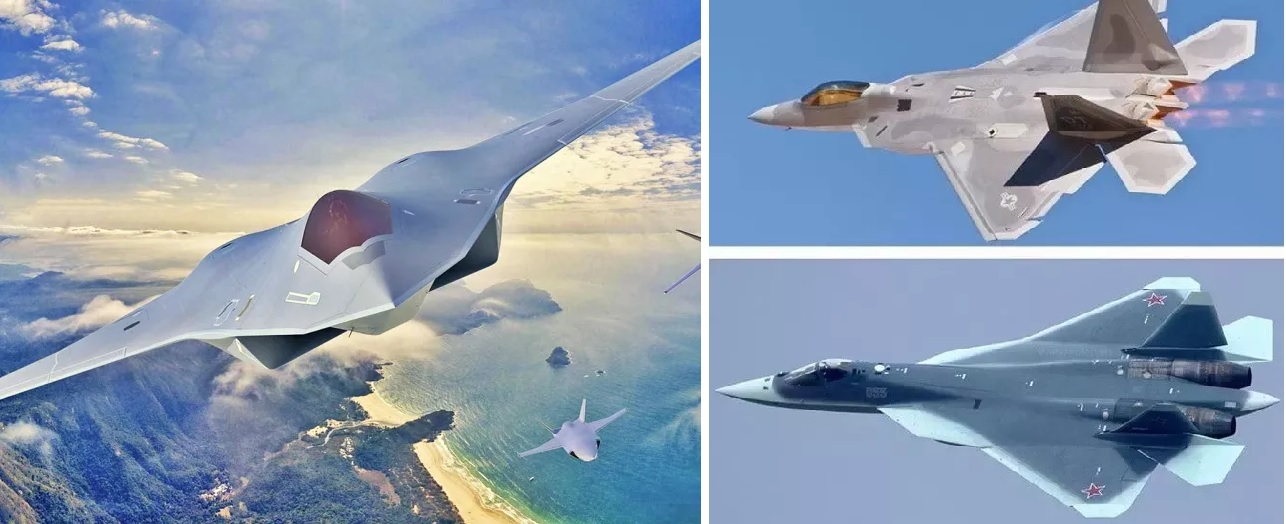 Key Differences Between 5th vs. 6th Generation Fighter Jets
Key Differences Between 5th vs. 6th Generation Fighter Jets
-
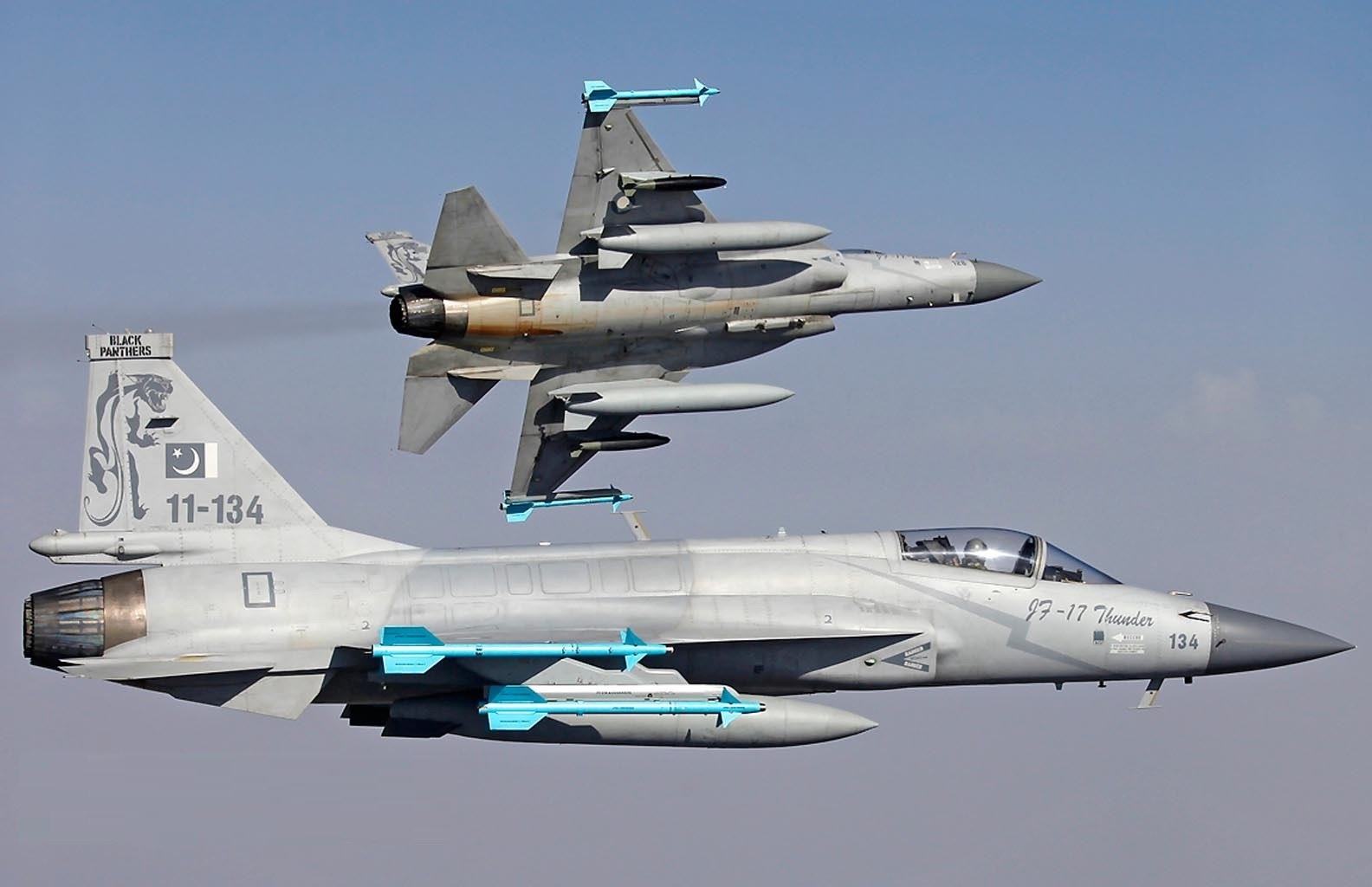 Pakistan Air Force to Unveil Stealth-Enhanced JF-17 Block 4 Fighter Jet by 2028
Pakistan Air Force to Unveil Stealth-Enhanced JF-17 Block 4 Fighter Jet by 2028
-
 India’s AMCA Engine Decision: Safran vs. Rolls-Royce Final Expected by 2025
India’s AMCA Engine Decision: Safran vs. Rolls-Royce Final Expected by 2025
-
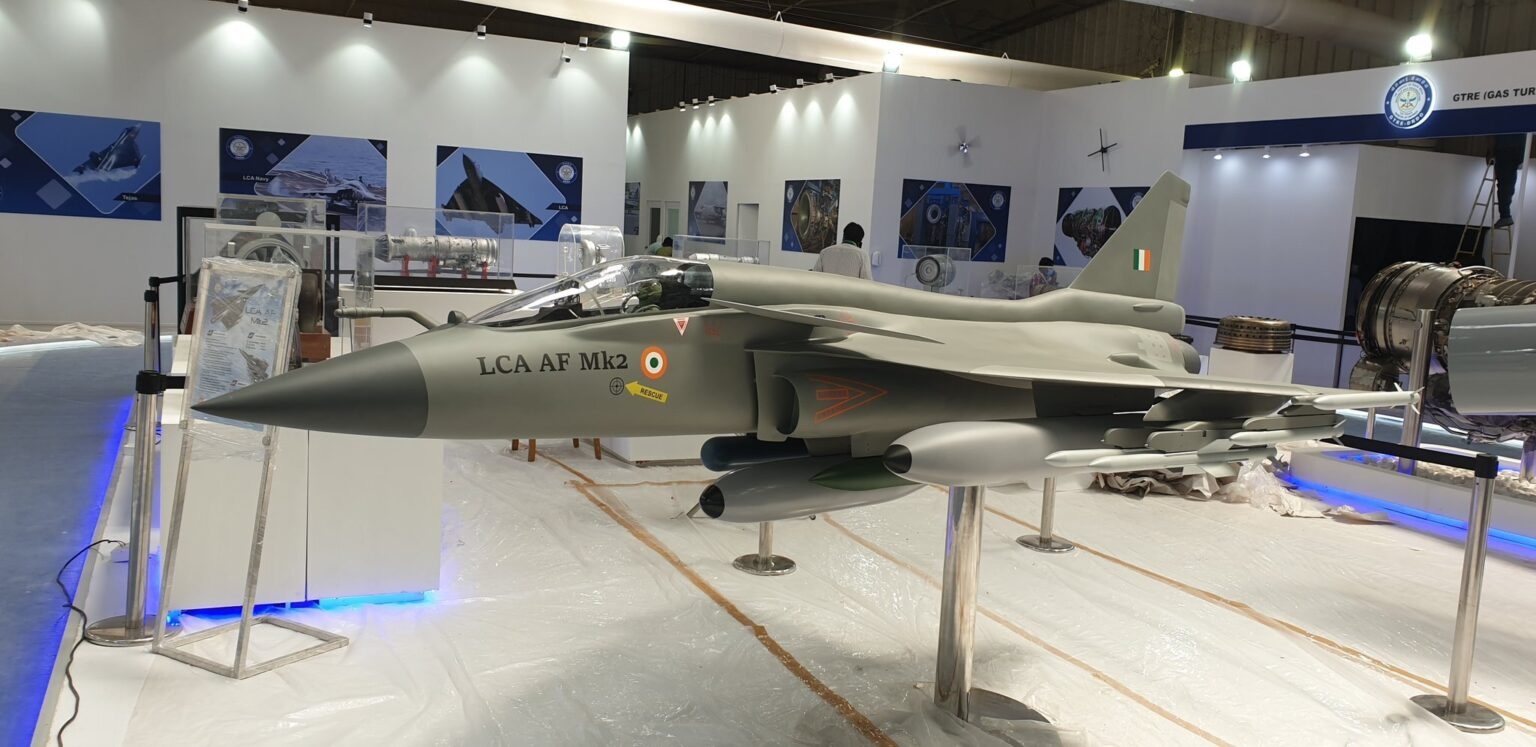 Tejas Mk2 Nears 2025 Rollout as HAL Ramps Up Final Assembly and System Integration
Tejas Mk2 Nears 2025 Rollout as HAL Ramps Up Final Assembly and System Integration
-
 Pakistan Announces 15% Increase in Defence Budget for 2024-25 Amid Economic Crisis
Pakistan Announces 15% Increase in Defence Budget for 2024-25 Amid Economic Crisis
-
 India's TEDBF Program Takes Shape First Flight by 2028: Aiming for Naval Supremacy with Advanced Stealth and Technology
India's TEDBF Program Takes Shape First Flight by 2028: Aiming for Naval Supremacy with Advanced Stealth and Technology
Top Trending in 4 Days
-
 Pakistan Army to Deploy Troops to Gaza by January 2026 Under Trump–Munir Deal, $500 Per Soldier
Pakistan Army to Deploy Troops to Gaza by January 2026 Under Trump–Munir Deal, $500 Per Soldier
-
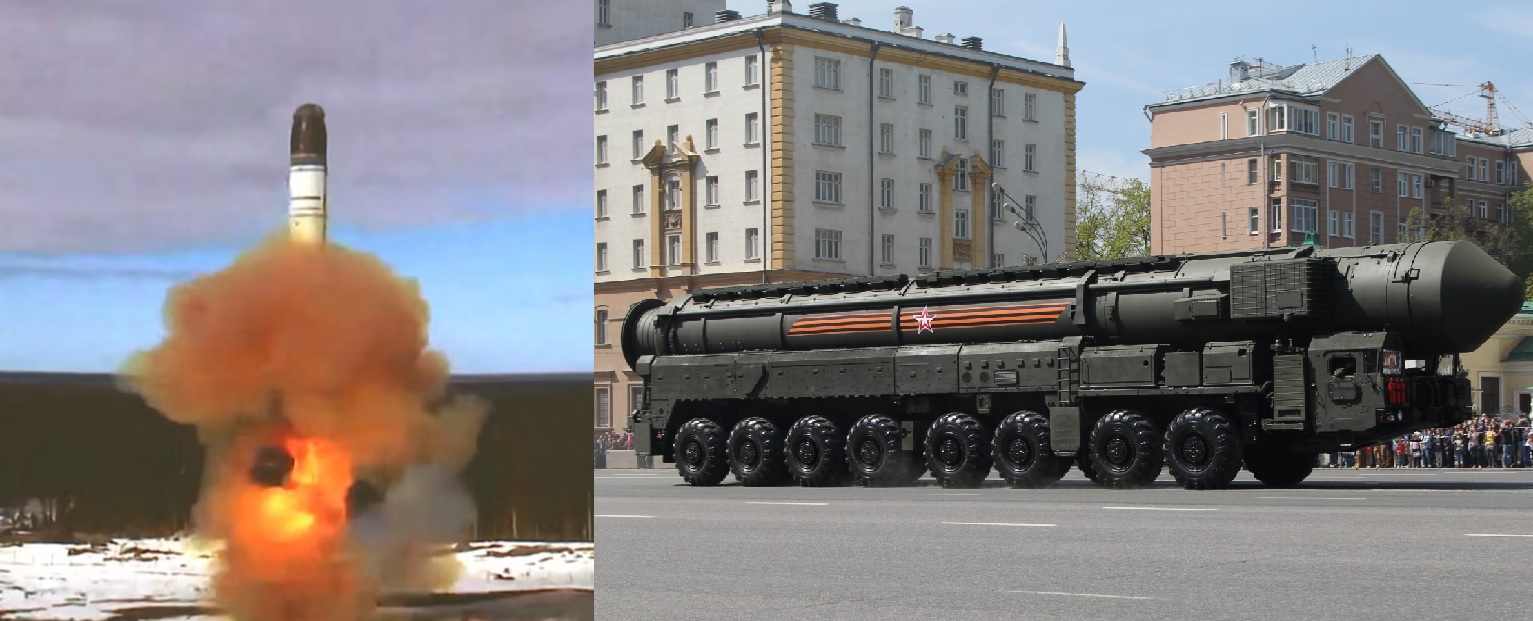 Russia Simulates Full-Scale Nuclear War in Siberia, Deploys Yars ICBMs on Combat Patrols
Russia Simulates Full-Scale Nuclear War in Siberia, Deploys Yars ICBMs on Combat Patrols
-
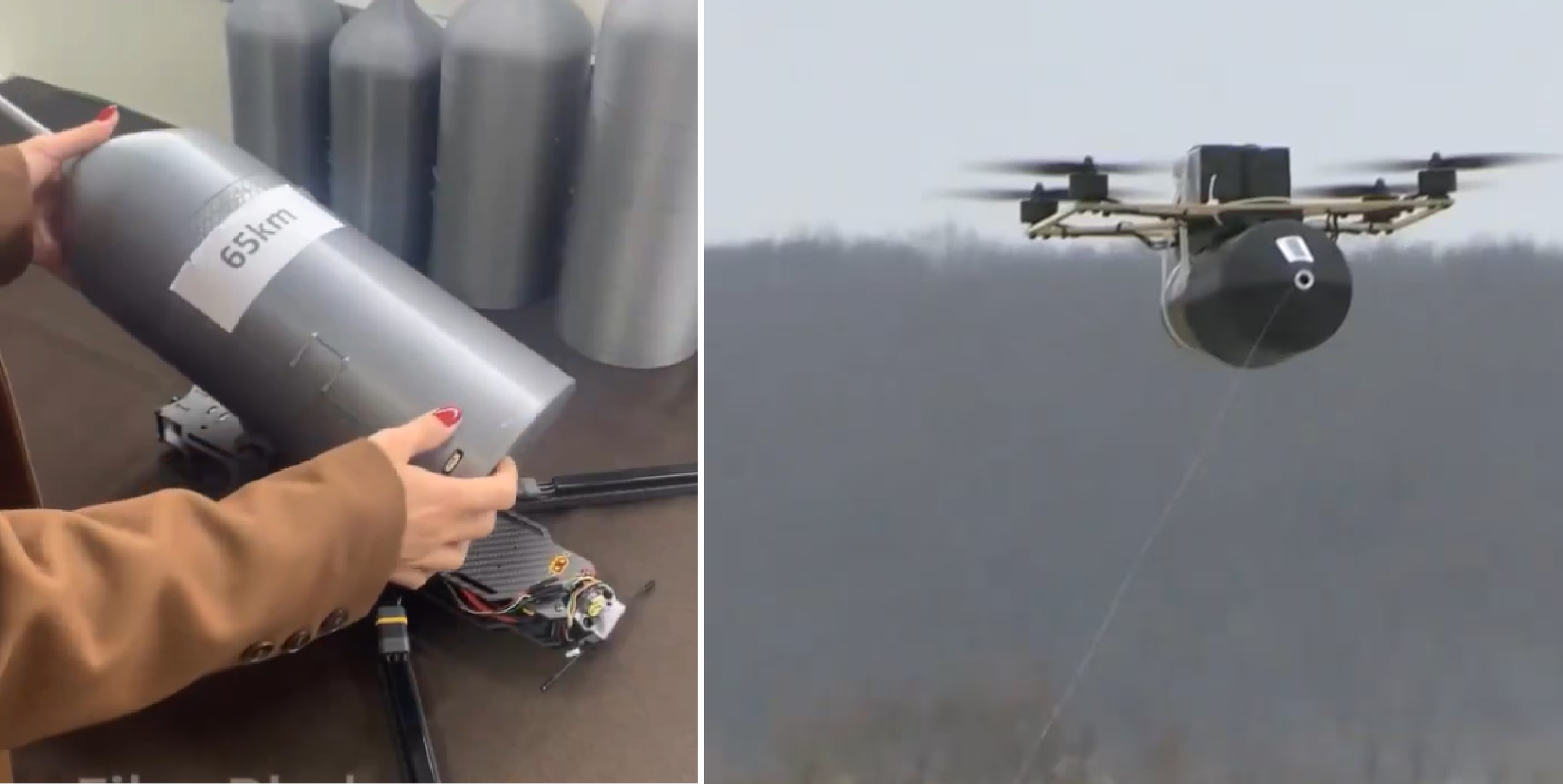 Russia Claims Test of 65-Kilometre Fiber-Optic FPV Drone Link
Russia Claims Test of 65-Kilometre Fiber-Optic FPV Drone Link
-
 ISRO Successfully Qualifies Drogue Parachutes for Gaganyaan Crew Module
ISRO Successfully Qualifies Drogue Parachutes for Gaganyaan Crew Module
-
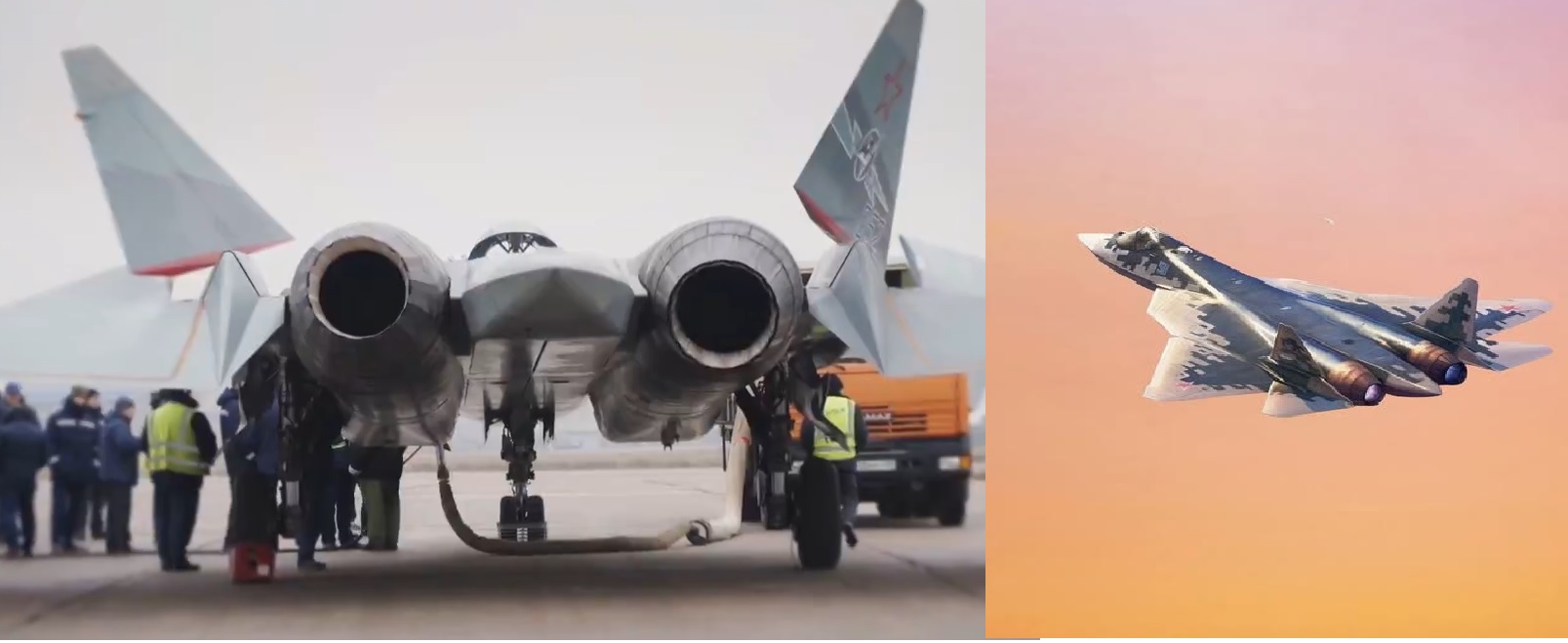 Russian Su-57 Conducts First Flight With Next-Generation Izdeliye-177 Engine
Russian Su-57 Conducts First Flight With Next-Generation Izdeliye-177 Engine
-
 Russian Strike on Mayaki Bridge Threatens Up to 60% of Ukraine’s Fuel Supply
Russian Strike on Mayaki Bridge Threatens Up to 60% of Ukraine’s Fuel Supply
-
 U.S. Seizes China-Linked Oil Tanker Carrying Venezuelan Crude in International Waters
U.S. Seizes China-Linked Oil Tanker Carrying Venezuelan Crude in International Waters
-
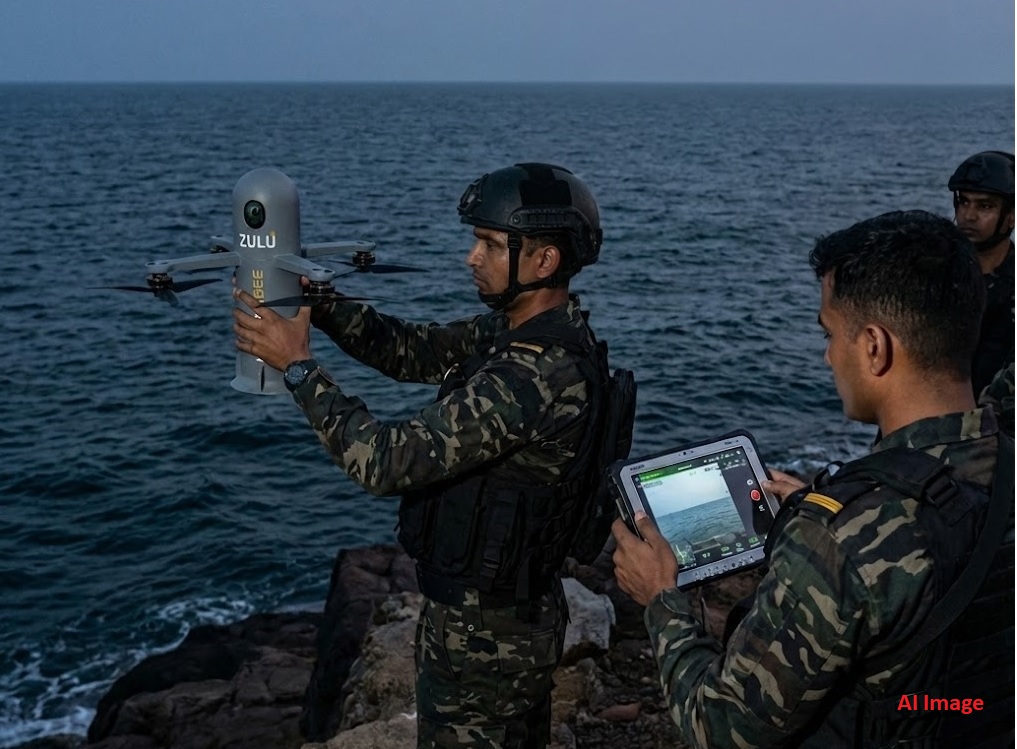 Indian Navy’s MARCOS Induct High-Tech ‘Hoverbee’ Kamikaze Drones for Stealth Operations
Indian Navy’s MARCOS Induct High-Tech ‘Hoverbee’ Kamikaze Drones for Stealth Operations
